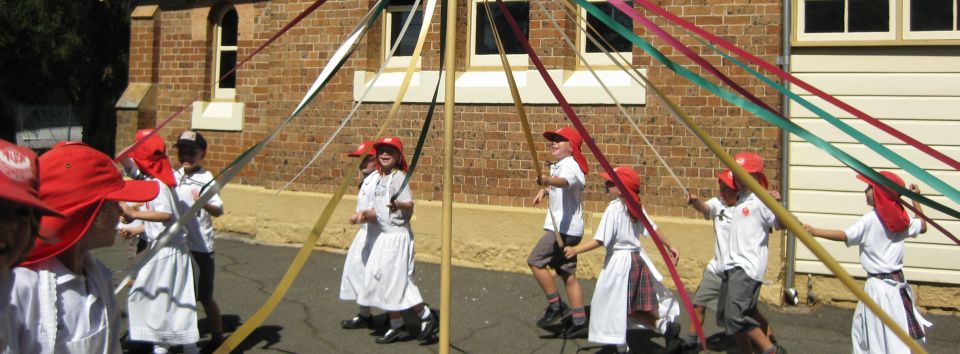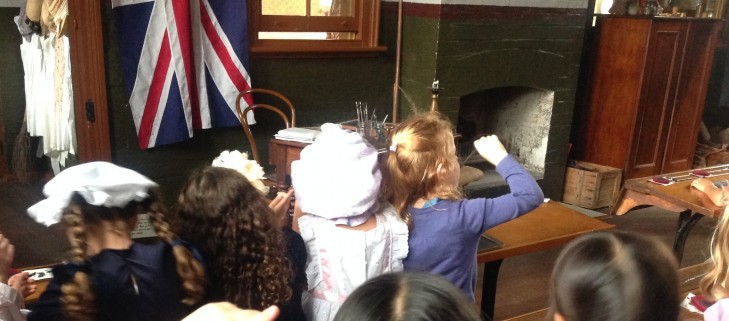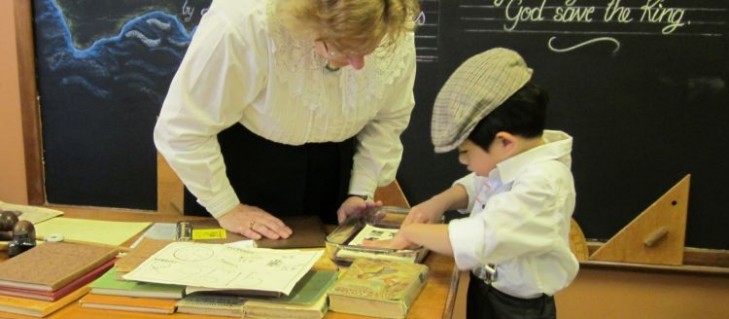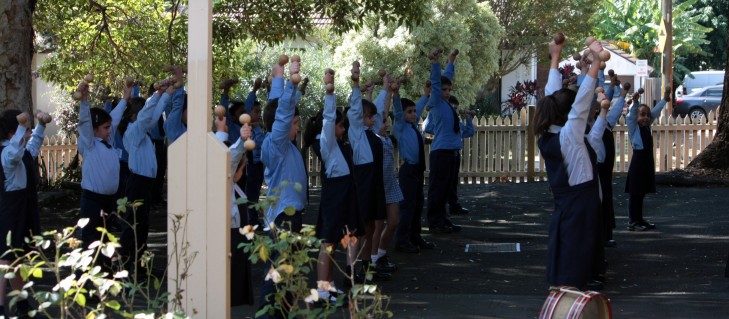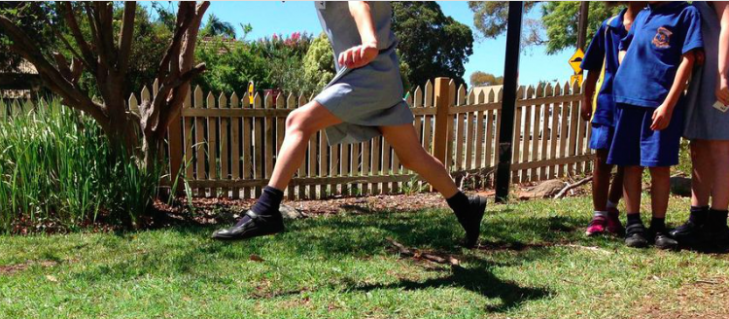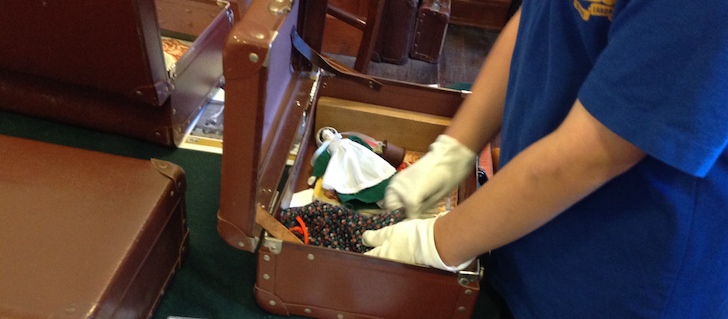Typical Visit
Also on this page:
- Typical visit for Stage 1 – School Communication in the Past
- Typical visit for Stage 1 – School Days of the Past
- Typical visit for Stage 2 – Continuity and Change
- Wet weather
- Facilities
- Medical matters
- Toast
Arrival and Departure Times
Most schools arrive around 10.00am and have a quick morning tea outdoors, ready to start the sessions by 10.25am. In winter, students collect kindling for the fire during this time. If two or three Stage 1 classes the program concludes at 1.00pm for lunch, with most schools staying to have lunch and a play in the grounds. The Stage 2 programs, and four class Stage 1 day, conclude at 2.00pm, with lunch between sessions.
A typical visit includes three or four 45 to 55 minute sessions, depending on the stage and student numbers.
Typical visit for Stage 1 – School Communication in the Past
1880s school lessons – ‘Writing is almost as important as speaking’
Integrated into a narrative about school, daily lives and technology of a time before electricity and motorised transport, students will use an ink pen for Copperplate writing and a slate pencil on a slate board. With a focus on orderly handwriting and decorative presentation, students will practise first on a slate board, then dip, write and blot to experience the challenges of neat pen and ink writing. Seated on a backless form at a timber long-tom students will also view an ornate blackboard, read a lesson on slates, chant tables and closely observe intricate1880s student book work.
Hands-on objects – communication of the 1930s, 40s and beyond
Focusing on the 1930s to 40s era of newly introduced electricity and telephone communications, students will handle and use a variety of historic objects. These include using a gelatine hectograph and rubber stamps for individual printing and examining communication tools on a headmaster’s desk such as a rotary dial phone, typewriter and hand duplicator. Other activities include a treasure hunt, unpacking a Globite suitcase for a school day and engaging with the true story of a young correspondence school boy who did his lessons by post. In winter terms, toasting and chatting by the open fire will be an optional extra activity in this session for schools who request it.
Step into the 1950s and 60s – the audio visual era
Seated at wooden 1950s desks and surrounded by examples of projectors, telephones and typewriters in a time of newly invented plastic, the transistor radio and black and white TV, students will experience some communication inventions of the time. They will write using a ‘modern’ ink pen of the 1960s with its rounded tip and ink reservoir, comparing it to the scratchy nibs of earlier times. Students will examine filmstrips, slides and projection equipment and other communication technologies of the era. The session will conclude with an interactive recreated Let’s Join In ABC Radio Broadcast for Schools. Schools with two or three classes can select this session or the outdoor session.
Outdoor activities – 1900s post and patter
This session uses story, games and play to consolidate understandings of 1880s-1900s communication modes of ink writing, mail and face-to-face talking. Using interactive clapping rhymes and story students will learn about communication of the early 1900s in the context of daily life at the time. They will open an ‘illuminated’ invitation and will practise skipping around a maypole in preparation. Recreating the children’s laughter and chatter in playgrounds and streets past, students will play co-operative games such as skipping, fly, quoits and What’s the time Mr Wolf. Schools with two or three classes can select this session or the 1950s-60s audio-visual session.
Typical Visit for Stage 1 – School Days of the Past
1880s re-created lesson
Seated at long-toms, the students re-enact aspects of daily lessons to gain an understanding of aspects of schooling in the past. The session includes chanting tables, writing with slate pencils on slate boards, using an early reader, viewing original 1880s pupils’ work, and writing Copperplate with pen and ink.
Interactive activities
Students engage with artefacts through activities such as finding objects and treasures, using rubber stamps and a jelly pad, examining contents of Globite school cases, studying photographs, playing with early puzzles and toys and, in winter, eating toast cooked over the fire.
Drill and maypole dancing
Students learn simple maypole dancing, dressed in pinafores or sailor collars if they wish. They undertake precision exercises using wands or dumb-bells.
Playground chants and games
Students play schoolyard games such as skipping, ‘fly’, quoits and bowling hoops. If four classes, they also learn some simple chants and play circle games.
Sample visit plans – download a sample excursion plan for Stage 1 School Days of the Past: Stage 1 – two classes, Stage 1 – three classes, Stage 1 – four classes.
Social story – download the Stage 1 social story to share with your students. This is in an inclusive format for students of all abilities.
Typical Visit for Stage 2 – Continuity and Change
1880s re-created lessons
Seated at original long-toms and forms, the students take part in aspects of 1880s daily lessons to gain an understanding of education in the past. Students will chant tables, write with slate pencils on slate boards, read from an early reader and write Copperplate with pen and ink. They will examine original 1880s pupils’ work and an early school punishment book to consider changes and continuities in learning and discipline.
1900s-1970s school resources investigation
Students work as ‘history detectives’ through activities such as finding and interacting with objects and treasures, examining contents of Globite school cases and studying photographs. In role as students from the past, they print from a jelly pad, label a map using pen and ink and do craft such as twisted threads, weaving or knitting. In winter they toast a piece of bread over the fire.
1900s drill and maypole dancing
Students learn precision exercises using wands and can wear lacy or sailors’ collars when learning simple maypole dancing.
1960s lessons and games
Students experience a short session in our recreated 1960s classroom where they observe the layout and use Cuisenaire Rods to complete number sentences. They play ‘fly’ or skipping with a long rope on the grass outside the room.
Sample visit plans – download a sample excursion plan for Stage 2 Continuity and Change – two classes, Stage 2 Continuity and Change – three classes and Stage 2 Continuity and Change – four classes.
Adverse weather
In rain, extreme heat or poor air quality some outdoor sessions are run in a modified format indoors. Students may do drill indoors and may do craft or an activity with Cuisenaire rods in our recreated 1960s room. If raining, maypole dancing will be omitted. If four groups in wet weather, the program may run as a three session rotation due to space limitations.
Facilities
For school groups there is a block of toilets, an undercover outdoor eating area and grassy grounds for playing. There are no tea and coffee making facilities. Take-away coffee can be purchased nearby in Cox’s Road or BYO thermos.
Medical Matters
Schools must bring their own first aid kit and emergency medications for their students. All museum staff are trained in e-Emergency, anaphylaxis and emergency asthma procedures. An Epi-Pen, first aid kit and Ventolin reliever is located on site.
Toast
White bread and golden syrup are used for toasting. Download images of the ingredient panels and packages.
Schools should supply alternative bread for students with special dietary requirements. Students with coeliac disease will be able to toast their own gluten free bread first using clean equipment.
Resources
Pre and post visit learning, information sheets, souvenirs, photo galleries and other links are on our Resources page.

